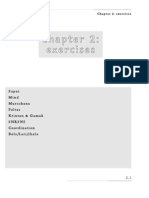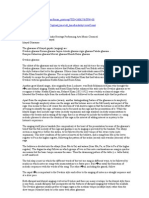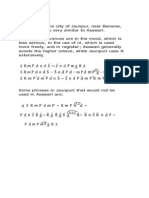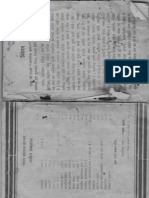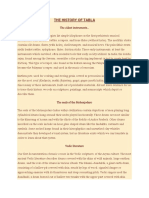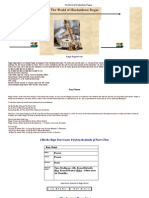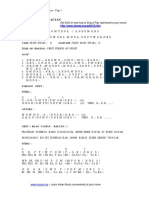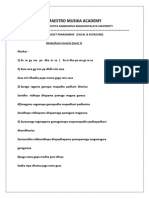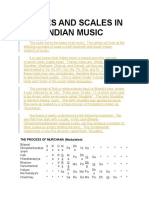Sitar Theory
Sitar Theory
Uploaded by
Dhanvi ShekharCopyright:
Available Formats
Sitar Theory
Sitar Theory
Uploaded by
Dhanvi ShekharCopyright
Available Formats
Share this document
Did you find this document useful?
Is this content inappropriate?
Copyright:
Available Formats
Sitar Theory
Sitar Theory
Uploaded by
Dhanvi ShekharCopyright:
Available Formats
DIVISION OF SWARS Shudha Sa Re Ga Ma Pa Dha Ni Komala Tivra
Re Ga Ma Dha Ni
SANGEET The combination of vocal music, instrumental music and dance is called Sangeet. Out of these different arts, Vocal music is the most distinguished art form because due to vocal music there is instrumental music and due to instrumental music there is dance but all the arts are independent. We can say that sangeet is that art in which we express our thoughts through swar and laya.
TWO MAIN SYSTEMS OF CLASSICAL MUSIC In India, there are two main systems of classical music: Southern or Karnataki Classical music karnataki is commonly practiced in Mysore, Madras, Andhra Pradesh and Karnataka. Northern or Hindustani Classical music Hindustani music is taught and practiced all over India except Mysore, Madras, Andhra Pradesh and Karnataka.
NAD Sangeet is related to melodious sound in which there is a regular interval or pattern. That particular sound that can be used in sangeet is called NAD. There are two types of Nad: Anahat Nad a sourceless nad not commonly heard and has no connection with sangeet. Aahat Nad the sound produced by human hand or while singing is known as Aahat nad. Aahat nad is of three types: The sound produced by the finger on table The sound produced by rubbing the bow on the violin The sound produced by blowing air into the flute.
CHARACERISTICS OF NAD 1. Magnitude or volume of Nad : One particular sound can either be produced softly or loudly. When the nad is sung softly, it is known as low vibration of Nad.This can be heard by the the person sitting very close to the person playing. When the same nad is produced loudly, it will be known as the high vibration of nad. This can be many people sitting far away 2. Timber- The ability to indentify different instruments or human voices just by listening to them is known as timber. 3. Pitch- every sound is either higher or lower than other sound. E.g- Sa Re in which Sa is lower than Re. The higher and lower notes are produced by the different vibration per second. The lesser vibration, the lower the sound and the higher the vibration, higher the sound per second.
SHRUTI Any kind of sound , melodious or simple, which can be heard clearly be the human ear is known as Shruti. But this is not an exact definition the sound that can be used in music as well as can be heard clearly by human ear and can be identified as different. There are 22 shrutis.
STHAN According to the vibration of sound, it(sound) has been divided into three parts :1. Lower parts or Madra saptak. 2. Medium parts or Madhya Saptak 3. Higher octave or Tara Saptak In playing, these three octaves are commonly used.
SWAR There are seven natural notes among 22 shrutis. The 7 notes are melodious and all are at a distance from each other. They are of two types : Shudha Swar When Sa Re Ga Ma Pa Dha Ni are situated on their definite places it is known as shudha swar. Vikrit Swar when Re, Ga, Ma,Dha, Ni are higher or lower from their original position, they are known as vikrit swar. They can be divided into two parts: Komal swar: the shifting of a note to the lower position is called Komal swar. E.g Re, Ga, Dha, Ni. Tivra swar- : the shifting of a note to the lower position is called Tivra swar. E.gma.
SAPTAK When a group of seven natural notes are recited, written or sung in an order, they are known as one spatak or an Octave. Eg Sa, Re, Ga, Ma , Dha, Ni. The frequency of each swar is higher than the previous one. There are three Types of saptak. Madra One saptak lower than the middle saptak. Madhya The natural singing saptak which is neither higher nor lower. Tara One saptak higher than the middle saptak.
Eg- rega. ( in a saptak, the andolan kriya of every swar is more thn the previous one).
THATT The seven notes of a particular saptak arranged in a proper ascending and descending order is known as thatt. Thatt is also known as mela. Rules or Niyam of Thatt 1. All the seven swars should always be present in a thatt. 2. The swars Sa, Re, Ga, Ma , Pa, Dha, Ni shoud be in the same order and should have the same names. 3. Thatt does not necessarily have Aaroh and avroh. 4. In a Raga, melody is necessary as we have to sing but melody is not necessary in thatt. 5. The particular thatt should be such that many ragas can be formed from it.
THATTS OF HINDUSTANI CLASSICAL MUSIC Kalyan Bilawal Aasavari Khamaj Todi Malwa Bhairav Bhairavi Kafi Poorvi
VARNA While playing or singing different types of kriya are known as varna. E.g- when we transcend from a lower note in a particular octave to a higher note . Varna is divided into four parts: Sthai Varna The meaning of it is to stay on one note in any given octave and recite it again and again. E.g- SSS, RRR, GGG, MMM ,PPP DDD, NNN. Aarohi varna When we sing notes from Sa Ni. E.g - Sa, Re, Ga, Ma , Pa, Dha, Ni. Avrohi varna when we sing notes from Ni sa. E.g Ni, Dha, Pa, Ma, Ga, Re, Sa. Sanchari Varna sanchari is a mixture of aarohi and avrohi varna. Eg RGP, PM, DS,RM,R, GGS, RS.
CHAL SWAR The swar which can change its original place is known as chal swar. Eg- Re, Ga, Ma , Dha, Ni.
ACHAL SWAR The swar which cannot change its original place is known as achal swar. Eg- Pa, sa.
ALANKAR Combination of notes is known as alanakar or repetition of certain notes throughout the octave. It is also known as palta.eg- Aaroh : SRSS, RGRR,GMGG, MPMM, PDPP, NSNN. Avroh : SNSS,NDNN, DPDD, PMPP, MGMM, GRGG, RSRR. The combination followed in aaroh is same as avroh.
JANAK THATT Thatt is a janak of every raga. Every thatt has many ragas under it and every raga belongs to a particular thatt. Eg- Sa, Re, Ga, Ma , Pa, Dha, Ni. It is shudha thatt. Raga Bilawal is formed by this thatt.
ASHRAYA RAGA By rule, the name of the thatt is taken from a particular raga. This particular raga after which a thatt is named is known as the Ashraya Raga.
JATI Jati is of three kinds : Sampoorna - 7 notes Shadav- 6 notes Odav 5 notes
VADI SWAR Among all the notes that are present in a raga, in which any one of the notes is used again and again. This particular note will be called vadi swar knowing the particular note enables us to know the name, time and the lakshan of the raga. Vadis war is also known by the following names: Ansh swar, Pradhan swar and Jina swar. Eg vadi swar of raga bhairavi is dha.
SAMVADI SWAR All the notes that are present in a raga in which one note is less prominent than the vadi swar. But more prominent than the rest of the notes. Yis is known as samvadi swar. There are two notes which are most important in a raga. Eg- Vadi & samvadi swar of raga bhairav are dha & re.
ANUVADI SWAR All the notes except vadi and samvadi used in a particular raga are known as anuvadi swars. Eg- in raga bhairav except vadi dha and samvadi re all the swars are anuvadi swars. Sa, Ga, Ma ,Pa, Ni.
VIVADI SWAR Some notes if used in a particular raga can cause the raga to become impure. These particular notes are known as vivadi swars. Eg- raga bhairav tivra ma.
VARJIT SWAR The swars which are not used in a particular raga are known as varjit swar. Eg ni, ma in raga bhopali.
GRAH SWAR The note with which we begin a particular raga is known as grah swar. Eg- re in aasavari.
ANSH SWAR The most important note ( swar) which is used again and again in a raga is ansh swar also known as vadi swar.
NYAS SWAR In the ancient times, the note ( swaras) on which the raga ended is known as nyas swar.
VAKRA SWAR While singing some swars are not used directly. They are used indirectly with the help of other swars. Eg SRSG ( re is vakra). GMGP ( ga is vakra)
PAKAD It is the certain combination of particular swars that helps us to identify the raga. Eg- NDMPDMG of raga khamaj.
POORVANGA & UTTARNAGA To equally divide one octave ( saptak) into two parts, we have added the higher Sa. The first part consisting of Sa, Re, Ga, Ma ,Pa then the second part Ma, Pa, Dha, Ni, Sa. Poorvanga Uttaranga Sa Ma Re Pa Ga Dha Ma Ni Pa Sa As the saptak is divided into two parts in the same way, 24 hours of a day are also divided into two parts. Poorvanga 12hrs 24 hrs ( 12 noon midnight) Uttarnga 24hrs 12 hrs ( midnight 12 noon)
POORVA RAGA & UTTAR RAGA Poorva raga- when the dominating notes of a raga are in the lower octave then it is called poorva raga. Sa, Re, Ga, Ma , Pa , Dha are sung between 12 hrs 24 hrs. Ga is the vadi swar of raga khamaj so it is called poorva raga. Uttar raga- vadi swar of raga bhairavi is dha so it can be called between midnight and 12 noon.
You might also like
- Sitar ExercisesDocument20 pagesSitar Exercisesapi-3854054100% (17)
- Orna Hidden InfoDocument17 pagesOrna Hidden InfoRichard WijayaNo ratings yet
- Microtonal Ragas Scales in Indian Classical MusicDocument5 pagesMicrotonal Ragas Scales in Indian Classical MusicxiaoboshiNo ratings yet
- History of Indian MusicDocument17 pagesHistory of Indian Musicsugandha26_gemini100% (1)
- Sitar NotesDocument177 pagesSitar Notesislacosmica100% (4)
- Major Chords Minor Chords No Thaat Notes: Compiled By: Kedar S. DamleDocument12 pagesMajor Chords Minor Chords No Thaat Notes: Compiled By: Kedar S. Damledamked100% (4)
- Hindustani Music SyllabusDocument3 pagesHindustani Music SyllabusJataveda BanerjeeNo ratings yet
- 1b Learning About TalasDocument7 pages1b Learning About TalasLisa BargeNo ratings yet
- Time Theory of RagaDocument3 pagesTime Theory of RagaeditorialIANo ratings yet
- SrutiDocument130 pagesSrutifghdsajklfhgjdNo ratings yet
- CDPD 500 - Living Photo Essay-3Document17 pagesCDPD 500 - Living Photo Essay-3api-533348723No ratings yet
- sp16 Seville Pocket Guide PDFDocument25 pagessp16 Seville Pocket Guide PDFionsiionescu6976No ratings yet
- Early Indian MusicDocument24 pagesEarly Indian MusicPavel BatalovNo ratings yet
- Bachlors of Music NotesDocument7 pagesBachlors of Music NotesVishnu PareekNo ratings yet
- Dhrupad of Mewar - FinalDocument6 pagesDhrupad of Mewar - FinalGianfranco TinelliNo ratings yet
- 101 Raga-S for the 21St Century and Beyond: A Music Lover's Guide to Hindustani MusicFrom Everand101 Raga-S for the 21St Century and Beyond: A Music Lover's Guide to Hindustani MusicNo ratings yet
- Learn Raga Dhanashri in 60 Minutes (Exotic Guitar Scales for Solo Guitar)From EverandLearn Raga Dhanashri in 60 Minutes (Exotic Guitar Scales for Solo Guitar)Rating: 5 out of 5 stars5/5 (1)
- Sitar Sindhu Bhairavi AlapDocument2 pagesSitar Sindhu Bhairavi AlapKamran_SaifNo ratings yet
- Sitar HandbookDocument4 pagesSitar HandbookGiordano PagottoNo ratings yet
- Chatura Pandit: V.N.Bhatkhande (Footnote 1)Document15 pagesChatura Pandit: V.N.Bhatkhande (Footnote 1)Mph MajNo ratings yet
- How To Mic A SitarDocument10 pagesHow To Mic A Sitartekaltian100% (4)
- MalkaunsDocument35 pagesMalkaunsBertie Alexander100% (2)
- Appreciating Hindustani MusicDocument15 pagesAppreciating Hindustani MusicAnonymous fO8xe7rMyANo ratings yet
- Classification of Raga by Time of The DayDocument4 pagesClassification of Raga by Time of The DayMontu ChakmaNo ratings yet
- Scales and ChalansDocument20 pagesScales and Chalansapi-3854054100% (11)
- Aakar - Hindustani Classical MusicDocument1 pageAakar - Hindustani Classical MusicprashanthNo ratings yet
- Yaman TutDocument10 pagesYaman TutPrathamesh KulkarniNo ratings yet
- Ashta Prahar (108 Melodies)Document126 pagesAshta Prahar (108 Melodies)kadamba_kanana_swamiNo ratings yet
- Raga Yaman NotationDocument6 pagesRaga Yaman NotationmeathatrNo ratings yet
- 06 Chapter2Document58 pages06 Chapter2Aravind Tr100% (1)
- On Carnatic Music Ragas 2Document3 pagesOn Carnatic Music Ragas 2Yogananthan BalakrishnanNo ratings yet
- Sitar Malkauns 1Document6 pagesSitar Malkauns 1Fabio Giaccone100% (1)
- 07 - Chapter 3 PDFDocument22 pages07 - Chapter 3 PDFAnonymous c40tCnNo ratings yet
- 09 - Chapter 3 A PDFDocument58 pages09 - Chapter 3 A PDFMadhurita Banerjee100% (1)
- Sruti Ranjani 2017Document38 pagesSruti Ranjani 2017VijayakumarNarasimhanNo ratings yet
- 09 Chapter 2Document94 pages09 Chapter 2Charuhas ChiplunkarNo ratings yet
- Indian MusicDocument3 pagesIndian Musicsanj4318No ratings yet
- Gamaka PresentationDocument13 pagesGamaka PresentationRohan RamananNo ratings yet
- Madhyamik Sangeet - 2Document57 pagesMadhyamik Sangeet - 2chandra-calgary75% (4)
- Ashutosh DRUPAD VARIOUS FORMDocument22 pagesAshutosh DRUPAD VARIOUS FORMkhalsaamanNo ratings yet
- Tabla HistoryDocument4 pagesTabla HistorySrikant RaoNo ratings yet
- The World of Hindustani RagasDocument13 pagesThe World of Hindustani RagasSanity Fair100% (1)
- Lec-Dem: Indian Classical (Hindustani) Vocal Music: E-Mail: Phone: (714) 996-0010Document4 pagesLec-Dem: Indian Classical (Hindustani) Vocal Music: E-Mail: Phone: (714) 996-0010Shambhu KumarNo ratings yet
- Carnatic Music Concert OverviewDocument9 pagesCarnatic Music Concert OverviewgokulNo ratings yet
- 07 - Chapter 3Document65 pages07 - Chapter 3Sanju100% (1)
- Carnatic Vocal Solo Arangetram, Varun KoduvayurDocument6 pagesCarnatic Vocal Solo Arangetram, Varun KoduvayurDhanya SubramanianNo ratings yet
- Music & Sahajyoga - DR - Arun ApteDocument209 pagesMusic & Sahajyoga - DR - Arun Aptekatikineni100% (3)
- Microtonality in Indian Music-Myth or RealityDocument5 pagesMicrotonality in Indian Music-Myth or RealityjagedsNo ratings yet
- Hindustani RagDocument61 pagesHindustani RagChintan Bhatt100% (3)
- Bahauddin Dagar - Interview - Rudra Veena PDFDocument12 pagesBahauddin Dagar - Interview - Rudra Veena PDFDiwas ChauhanNo ratings yet
- 07 - Chapter 1 PDFDocument46 pages07 - Chapter 1 PDFPrashant PatilNo ratings yet
- Samayas of RagasDocument44 pagesSamayas of RagasWell Wisher And Seeker100% (3)
- Essential Tala Elements in Lalgudi G. Jayaraman's ThillanasDocument22 pagesEssential Tala Elements in Lalgudi G. Jayaraman's Thillanascurtisandrews100% (1)
- Comparison of RagasDocument5 pagesComparison of Ragassuriyaprakash100% (1)
- Training in Indian Classical Music: "Riyaz"Document57 pagesTraining in Indian Classical Music: "Riyaz"shadjamadhyam86% (7)
- Vocal Yaman Kalyan PDFDocument2 pagesVocal Yaman Kalyan PDFSandy43% (7)
- Sangeet Prarambhik V+CDocument31 pagesSangeet Prarambhik V+CpoojaNo ratings yet
- Modes and Scales in Indian MusicDocument4 pagesModes and Scales in Indian MusicLakmé IndiraNo ratings yet
- Dhrupad and BishnupurDocument15 pagesDhrupad and BishnupurArijit BoseNo ratings yet
- 08 Chapter 2Document22 pages08 Chapter 2Jaliya KumarasingheNo ratings yet
- Ashish Sankrityayan On DhrupadDocument15 pagesAshish Sankrityayan On DhrupadWim De WinterNo ratings yet
- Mage DossierDocument16 pagesMage Dossierfrossi_yop83% (12)
- A Method of Protecting Oneself From Psychic AttacksDocument6 pagesA Method of Protecting Oneself From Psychic AttacksAn Ling100% (2)
- Exegetical Fallacies by D A Carson 0801020867 PDFDocument5 pagesExegetical Fallacies by D A Carson 0801020867 PDFTrifena SiahaanNo ratings yet
- Course: Ancient Cultures and Civilization of India Code: 5672 Semester: Autumn, 2020 Assignment No. 2Document27 pagesCourse: Ancient Cultures and Civilization of India Code: 5672 Semester: Autumn, 2020 Assignment No. 2Nargis RasheedNo ratings yet
- V e D A SDocument35 pagesV e D A SVeraaryans 22100% (1)
- The Vocalist Magazine Spring IssueDocument156 pagesThe Vocalist Magazine Spring Issuesbiks0% (1)
- Channel Your English Beginners - Test Booklet Final Exam A. Listen To Four Short Conversations and Answer The Questions. Circle A, B or C. (8 Marks)Document4 pagesChannel Your English Beginners - Test Booklet Final Exam A. Listen To Four Short Conversations and Answer The Questions. Circle A, B or C. (8 Marks)Krisztián SimonNo ratings yet
- Wigjig Video 4 On Making A Bead Dangle by Selecting HereDocument24 pagesWigjig Video 4 On Making A Bead Dangle by Selecting HereRene Irrma100% (1)
- A Long Walk To ForeverDocument5 pagesA Long Walk To ForeverBuckweet789No ratings yet
- Sample Persuasive TextDocument1 pageSample Persuasive TextKarmelo LazaroNo ratings yet
- Penulisan Kutipan & Daftar Pustaka Menurut APADocument14 pagesPenulisan Kutipan & Daftar Pustaka Menurut APATuti HandayeniNo ratings yet
- Past Present Future Simple Continuous Perfect Perfect ContinuousDocument2 pagesPast Present Future Simple Continuous Perfect Perfect ContinuousiwanrwpNo ratings yet
- Chibana Chosin SenseiDocument6 pagesChibana Chosin Senseishaolinkungfu100% (1)
- Past Experiences (SB) PDFDocument6 pagesPast Experiences (SB) PDFMuhammad alfiannorNo ratings yet
- African Studies and Afrocentric Paradigm A CritiqueDocument7 pagesAfrican Studies and Afrocentric Paradigm A CritiqueVyntagGreenNo ratings yet
- Descendents of Don Juan CanalesDocument45 pagesDescendents of Don Juan CanalesJose Vicencio100% (2)
- Nozzle Calculation - Auxiliary Boiler Stack-R0Document13 pagesNozzle Calculation - Auxiliary Boiler Stack-R0Aditya Jain100% (1)
- Unit 1: Palawan State UniversityDocument15 pagesUnit 1: Palawan State Universitynadine maglalangNo ratings yet
- Ultimate Chocolate CakeDocument2 pagesUltimate Chocolate CakeraabiahNo ratings yet
- Case StudyDocument21 pagesCase StudySydney PoolemanNo ratings yet
- Straight Lines AssingmentDocument5 pagesStraight Lines Assingmentshuchi guptaNo ratings yet
- Heels Over HeadDocument2 pagesHeels Over HeadJosefina Carmen RoaNo ratings yet
- Electrical BOQDocument100 pagesElectrical BOQPrakashNo ratings yet
- Actividades de Ingles Ciclo 5Document4 pagesActividades de Ingles Ciclo 5Jiduar CastilloNo ratings yet
- Forensics B - Unit 3 - ActivityDocument2 pagesForensics B - Unit 3 - ActivitykaelNo ratings yet
- Module 2 FinalDocument112 pagesModule 2 Finalaparna baburajNo ratings yet
- Pinhole CameraDocument4 pagesPinhole CamerajainNo ratings yet
